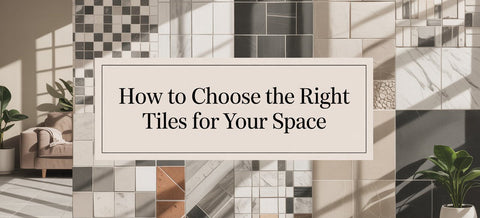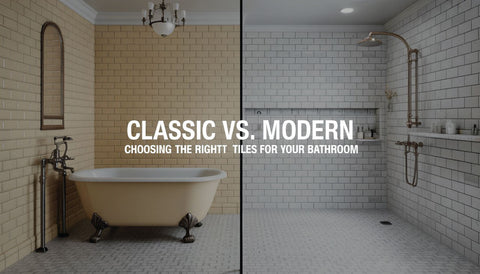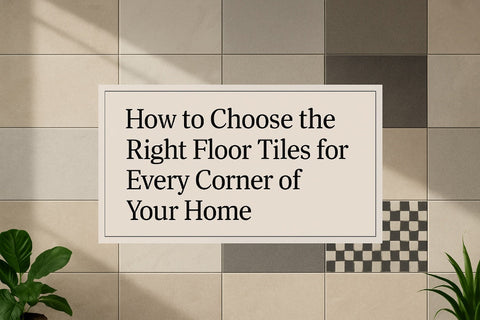When it comes to designing a beautiful and functional space, texture plays a key role. Tile textures are not just a visual delight—they influence how a space feels, performs, and interacts with light. The right tile finish can bring out the personality of your interiors or exteriors, whether you're seeking a sleek modern look, a rustic charm, or a luxurious ambiance. At Axar Tiles, we believe that choosing the right tile texture is just as important as selecting the colour , size, or pattern.
In this comprehensive guide, we explore five key tile texture categories to help you make the best choice: Glossy vs Matt Dew tiles, Honed marble vs Polished marble, Tumbled and Flamed stone, Brushed wood-effect tiles, and Texture blending techniques for artistic tile pairing. Each finish not only carries a unique visual appeal but also offers different performance features in terms of slip resistance, ease of cleaning, light reflection, and surface durability.
For instance, Glossy tiles are great for enhancing brightness and a sense of openness in compact rooms, while Matt Dew tiles provide a calm, earthy elegance with anti-slip properties. Similarly, understanding the difference between honed and polished marble helps in choosing the right marble tiles for bathrooms, living rooms, or commercial settings. Textures like flamed and tumbled finishes bring rugged naturalness perfect for outdoor spaces, and brushed wood-effect tiles in uk offer a beautiful compromise between warm aesthetics and low-maintenance performance.
What sets Axar Tiles apart is our curated range of textures designed for specific moods and spaces. From urban lofts and serene spa-style bathrooms to lively kitchens and durable outdoor patios, our tiles combine form and function to elevate your lifestyle.
By the end of this guide, you'll understand how to strategically use tile textures not only to beautify your spaces but also to enhance comfort, safety, and functionality. Whether you’re a homeowner planning a renovation or a designer crafting a fresh new space, this guide will serve as your go-to reference.
Let’s begin with the first comparison: Glossy vs Matt Dew tiles — and understand how each texture creates a completely different visual and tactile experience in your space.

Honed Marble Elegance vs Polished Marble
When designing a luxurious and timeless space, marble tiles remain an unmatched choice. But within this elegant material, there’s an important texture decision to make—Honed marble or Polished marble? Each finish offers a distinct look and feel, and understanding their differences can help you craft the perfect ambience for your project. At Axar Tiles, we offer both options in a range of colours and sizes, ideal for everything from marble floor tiles to marble bathroom tiles in uk.
Polished marble is known for its smooth and mirror-like shine. This highly reflective surface elevates any room, giving it a sense of opulence and grandeur. It's a popular choice for floor tiles in living rooms, hotel lobbies, and upscale commercial spaces. The polished finish enhances marble's natural veining, making each tile in a piece of art.
Its glossy surface is also easier to wipe clean, which makes it an attractive option for white wall tiles and white kitchen tiles, where hygiene and visual appeal matter most.
On the other hand, Honed marble has a matte, velvety texture . It is created by grinding the marble's surface to a smooth, flat finish without a shine. This makes it more slip-resistant than polished marble and better suited for high-traffic areas or wet zone, like bathroom porcelain tiles. Honed marble delivers understated elegance—perfect for modern, minimalist interiors or rustic-inspired designs.
When comparing ceramic wood tile to natural finishes like honed marble, the key distinction lies in the tactile experience. Honed marble has a natural stone feel underfoot, and ceramic wood mimics the grain and warmth of real wood. However, for those seeking authentic, earthy luxury with durability, honed marble is a top-tier option.
Another consideration is maintenance. Polished marble requires regular care to maintain its sheen, as it can show scratches and etching from acidic substances. Honed marble, though more forgiving in terms of marks, can absorb stains more easily if not sealed properly. That’s why, at Axar Tiles, we recommend using high-quality sealants and cleaners to ensure the longevity of both finishes.
In terms of application, polished marble excels in areas where visual impact is the priority. Think accent walls, grand entryways, and feature floors. Honed marble, however, is best for places where safety, comfort, and a softer look are more important, such as in outdoor porcelain tile areas or kitchen ceramic floor tiles where slip resistance is vital.
Ultimately, the choice between honed vs polished marble tiles depends on the vibe you want to create. If you crave high-end glamour and light-reflecting luxury, polished marble is your go-to. If you prefer a grounded, natural atmosphere with slip-resistance and subtlety, honed marble is ideal.
At Axar Tiles, we help you match the right marble finish to your lifestyle and space—ensuring your surfaces not only look exquisite but also perform beautifully for years to come.

Tumbled and Flamed Stone
When it comes to adding rugged character and tactile depth to your space, tumbled and flamed stone finishes stand out as bold, timeless choices. At Axar Tiles, we believe that a tile's texture is just as important as its colour or pattern—especially in areas that demand both aesthetic charm and practical durability. Whether you're selecting floor tiles for a living room, marble bathroom tiles, or considering exterior surfaces, tumbled and flamed stones offer texture-rich solutions that beautifully balance form and function.
Tumbled stone is all about soft edges, natural charm, and antique aesthetics. These tiles are created by placing natural stone in a rotating drum with sand, water, and abrasives that gently wear down sharp edges. The result? A surface that looks weathered, slightly porous, and irresistibly organic. Tumbled tiles are particularly suited for outdoor porcelain tile setups like garden paths, pool decks, or rustic patios, where slip resistance and visual softness are key.
On the other hand, flamed stone offers a more dramatic, rugged surface. Flamed finishes, which are produced by exposing stone (typically granite) to intense heat, cause the crystals on the surface to burst and produce a rough texture, are excellent for high-traction needs. Think kitchen ceramic floor tiles where spills are frequent or tile wood plank surfaces in outdoor areas that face heavy foot traffic. These finishes are not only visually striking but also incredibly functional, resisting both slips and stains.
When you compare the tactile warmth of a ceramic wood tile to the natural grip of flamed stone, you’ll notice how the latter adds a bolder, more grounded energy to the space. While wood-look tiles aim for cozy aesthetics, flamed stones convey strength and resilience. Both have their place—Axar Tiles offers a curated range that allows for clever texture blending based on use and design goals.
Maintenance-wise, tumbled tiles are relatively easy to clean but may require sealing to prevent stains, especially when used as white wall tiles or in white kitchen tile backsplashes. Flamed stone, being coarser, is great at hiding imperfections but should also be sealed to avoid deep absorption of liquids or grime.
Stylistically, both tumbled and flamed finishes bring an artisanal quality that’s hard to replicate. Tumbled finishes work well in Mediterranean, farmhouse, or vintage-inspired designs, especially when paired with marble floor tiles in complementary tones. Flamed tiles, however, shine in industrial, contemporary, or even nature-inspired themes—where raw textures dominate.
Ultimately, your choice depends on how much rustic or rugged texture you want your space to convey. Tumbled stone gives a softer, lived-in appearance, while flamed stone offers bold, coarse contrast. When blended creatively—like using flamed stone for flooring and tumbled tiles for accent walls—you create a visually rich, tactile experience that elevates every inch of your space.
Trust Axar Tiles to deliver the finest selection of tumbled and flamed stone textures, crafted for spaces that demand both beauty and brawn.

Brushed Wood-Effect Tiles
Brushed wood-effect tiles have emerged as a favourite among interior designers and homeowners who crave the warmth of wood but require the practicality of tiles. At Axar Tiles, we specialize in creating realistic, durable, and visually rich ceramic wood tile and wood plank options that mimic the natural grain and tone of hardwood flooring while delivering superior resilience. These tiles combine the best of both worlds earthy aesthetics and long-lasting performance.
What makes brushed wood-effect tiles stand out is their unique surface texture. The brushing technique removes the softer grains from the surface, leaving behind a subtly ridged texture that closely resembles real wood. This tactile finish not only enhances visual authenticity but also improves grip underfoot, making it ideal for use as floor tiles for living rooms, kitchen ceramic floor tiles, or even outdoor porcelain tiles in shaded patios or balconies.
One of the key advantages of ceramic wood tile is its resistance to moisture, stains, and daily wear and tear. Unlike actual wood, which can warp or scratch easily, wood-look tiles are perfect for high-traffic or wet areas such as porcelain tiles for bathroom settings or mudrooms. The brushed texture also adds dimension to your interiors, playing with natural and artificial light in intriguing ways.
Design-wise, these tiles are incredibly versatile. You can choose from classic oak and walnut shades to contemporary grey or whitewashed tones, depending on your aesthetic goals. For modern kitchens, white kitchen tiles, with a glossy backsplash pair beautifully with soft beige or grey tile wood planks, striking a balance between elegance and comfort. In rustic or boho interiors, brushed wood tiles in warmer tones elevate the coziness factor instantly.
Another brilliant feature is how well brushed wood-effect tiles blend with other materials. Imagine combining marble bathroom tiles with warm-toned wood-effect flooring—it creates a luxurious spa-like ambiance without compromising functionality. The same goes for living spaces; using marble floor tiles as accents or borders around a brushed wood-look centre area creates layers of visual interest and sophistication.
From an eco-conscious perspective, ceramic wood tile is a more sustainable alternative to real wood flooring. No trees are cut down, and the tile manufacturing process at Axar Tiles ensures reduced environmental impact through modern kilns and recyclable materials.
Maintenance is also a breeze. These tiles don’t require polishing or sealing like real wood. Regular sweeping and an occasional mop with mild detergent are all it takes to keep your floors looking brand new. Plus, with their textured finish, minor dirt or dust is less visible—perfect for busy households or commercial areas.
Whether you're aiming for a Scandinavian, industrial, or farmhouse look, brushed wood-effect tiles deliver timeless appeal with minimal upkeep. At Axar Tiles, our curated range of ceramic wood tile and tile wood plank options is designed to inspire. Add texture, warmth, and authenticity to your interiors with tiles that look like wood but last like stone.

Texture Blending: Crafting Contrast with Tile Pairing
In the world of interior design, creating visual harmony often comes down to the art of texture blending—the strategic combination of tiles with different surface finishes to add depth, interest, and contrast to a space. At Axar Tiles, we champion the use of innovative tile pairing techniques that allow homeowners and designers to craft truly one-of-a-kind interiors using our extensive range of textures like marble bathroom tiles, tile wood planks, outdoor porcelain tiles, and white wall tiles.
Texture blending works by combining complementary or contrasting tile finishes—such as glossy with matte, polished marble with textured stone, or smooth ceramic wood tile with rough-hewn slate—to create visual balance and tactile appeal. For example, pairing glossy white kitchen tiles with brushed wood-effect floor tiles not only grounds the space but also enhances natural light by reflecting it subtly off the walls. This kind of pair works well in both modern and transitional kitchens.
In living rooms, designers often blend marble floor tiles with textured borders or patterned inserts like tile wood planks to define zones or create striking centre pieces. This pairing delivers a sophisticated look while making the space feel layered and dynamic. Similarly, in bathrooms, the combination of porcelain tiles for bathrooms with either tumbled stone or honed marble adds spa-like serenity and richness to even the smallest spaces.
Texture blending also allows you to elevate functionality. For instance, outdoor porcelain tiles, with flamed finishes offer grip and durability, making them ideal for patios or balconies, while pairing them with smoother floor tiles for living rooms at the transition point creates a seamless yet intentional flow from indoor to outdoor living. At Axar Tiles, our product collections are designed to support these transitions with coordinating tones and complementary textures.
When done correctly, blending textures can also help highlight architectural features. Placing white wall tiles in a herringbone pattern behind open shelves while using marble bathroom tiles around the vanity, for instance, can add dimension and help the space feel more curated and upscale. It’s about telling a design story—using surfaces to guide the eye, frame focal points, or bring warmth and contrast where needed.
From a practical perspective, texture pairing can be used to denote functionality. For example, using kitchen ceramic floor tiles in a matte finish around the cooking zone and switching to a slightly glossy tile near dining areas can subtly define spaces without adding walls or transitions.
At Axar Tiles, we urge homeowners to think of tiles not just as finishes, but also as a design. language. Through our diverse collection of tile wood planks, ceramic wood tile, marble floor tiles, and more, we offer endless opportunities to blend textures that reflect your unique personality and style. Whether you're curating a serene bathroom retreat or a bold, expressive kitchen, mastering the art of texture blending ensures your home will never look one-dimensional.
Frequently Asked Questions (FAQ) – Tile Textures & Finishes by Axar Tiles
What’s the difference between honed marble and polished marble?
Polished marble has a glossy, mirror-like finish that highlights the stone’s natural veining and adds luxurious shine—perfect for feature walls and upscale floors.
Honed marble, on the other hand, offers a matte, velvety texture that’s more slip-resistant, making it ideal for bathrooms, kitchens, and high-traffic zones.
Are brushed wood-effect tiles better than real wood flooring?
Yes! Brushed ceramic wood tiles mimic the grain and feel of real wood but are far more resistant to stains, moisture, and scratches. They’re ideal for living rooms, kitchens, and outdoor patios, offering the warmth of wood with the durability of tile.
Where can I use tumbled and flamed stone tiles?
- Tumbled stone is great for rustic patios, garden paths, or pool decks due to its weathered, organic look and anti-slip surface.
- Flamed stone is ideal for high-traction areas like outdoor entrances, industrial kitchens, or pathways, as its rough texture offers excellent grip and stain resistance.
Can I use wood-look tiles in my kitchen? I want something that looks like wood but is easy to clean.
Absolutely! Our ceramic wood-effect tiles are perfect for kitchens. They offer the cozy look of natural wood but are stain-proof, scratch-resistant, and easy to clean—unlike real wood which can warp or get damaged by spills.
Are flamed stone tiles safe for outdoor use? I’m looking for something slip-proof for my patio.
Yes, flamed tiles are one of the best choices for outdoor patios, balconies, and pool decks. Their rough texture provides excellent grip and they also handle weather changes really well.
What’s the advantage of tumbled stone tiles? Do they look too rustic?
Tumbled tiles have a soft, worn-in look that adds charm and character. They’re perfect for rustic, vintage, or farmhouse styles—but don’t worry, they don’t look outdated. They’re anti-slip, durable, and work beautifully for walkways, garden areas, or even bathroom floors.
Will glossy tiles make my small bathroom look bigger?
Yes! Glossy tiles reflect light, which makes small spaces feel brighter and more spacious. They’re ideal for compact bathrooms, powder rooms, and narrow corridors.
Do I need to seal honed or flamed tiles? I want something low maintenance.
For the best results, yes—we recommend sealing honed and flamed tiles to prevent stains and moisture buildup. But the good news is, once sealed, they’re super easy to maintain.
Which tile is best for kitchen floors where there’s a lot of cooking and spills?
We suggest using matte ceramic or flamed stone tiles in kitchens. They provide grip, resist stains, and are easy to clean—plus, they can handle all the hustle and bustle of a busy kitchen.




